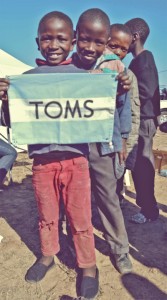As Michael Matheson Miller states, the idea of a one-to-one business model merely provides impoverished people with a “Band-Aid” that only fixes one injury. It does not prevent future injuries from occurring, but it is a short-term solution for the one that is affecting that mother, father, child, or sibling now. This rationale is extremely short-sighted. Lacking the “infrastructure” and knowledge to attain wealth, these people are left hopeless when given something. Yes, they may be slightly more comfortable in their new pair of Toms, that is only until the Toms become worn and unwearable. Giving these people a singular pair of shoes is not the answer to solving the big picture of poverty. Not to mention, it destroys their own local businesses, which puts even more pressure on already struggling economies.
The solution to this one-to-one business model is to teach these impoverished people. Teaching them how to make basic things while also influencing them to have entrepreneurial mindsets will be more promising in the long run than just giving them materialistic goods. Providing them with these basic skills will propel them to do much more with their lives –it will propel them to escape the destructive cycle of poverty.
Sources: http://knowledge.wharton.upenn.edu/article/one-one-business-model-social-impact-avoiding-unintended-consequences/
Photo: https://www.google.ca/url?sa=i&rct=j&q=&esrc=s&source=images&cd=&ved=0CAcQjRxqFQoTCNzV4ey9mMkCFYmUiAodGrQKXw&url=https%3A%2F%2Fwww.msh.org%2Fnews-events%2Fstories%2Fno-more-bare-feet-msh-and-toms-distribute-shoes-to-children-in-lesotho&bvm=bv.107763241,d.cGU&psig=AFQjCNG4Q967kJI0htm9EjaUw4ULnP3v6g&ust=1447884842384864
